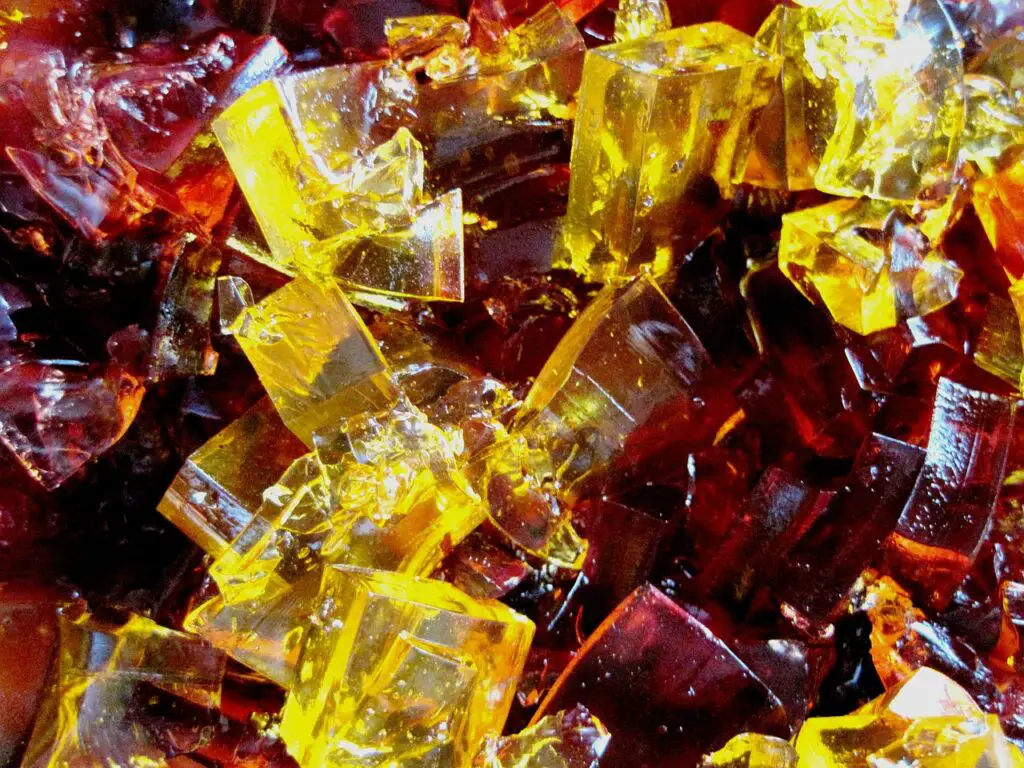Picture this; you are watching a movie and enjoying a bowl of jello, and your dog is sitting next to you begging for a taste.
You may have even given in a time or two, but is it really safe?
Can dogs eat jello?
Yes.
Dogs can eat jello provided it’s homemade and in moderation.
Most store-bought Jello are loaded with sugars and artificial sweeteners like xylitol which can be life-threatening to your pups.
Jello in large amounts can cause diabetes, obesity or hypoglycemia.
Alternatively, find dog-safe treats for your furry friend.
In this article, we are discussing the ingredients in jello, their safety, and health benefits.
We will also share jello alternatives that you can feed your dog.

What is jello?
Jello is a gelatin-based dessert made by boiling animal skin and bones.
When the broth cools down, it leaves insipid wobbly jello with no color or flavors.
Brands then add food colors, flavors, and other additives such as sugars or xylitol to produce the end product bought in stores.
Anyone can easily make jello at home for their pup; all you need is gelatin powder and flavoring, preferably natural ones like honey.
Homemade jello with minimal to zero sugar is safe for your dog.
However, feed your hound jello in moderation to avoid health problems.
Do not feed your dog with store jello because they contain high amounts of sugar or are flavored with xylitol which is toxic to your dog.
If you have to give your dog jello, home-make it and put in healthy alternatives discussed later.

What are the ingredients in jello?
The main ingredients in many jello brands are water, gelatin, sugar or xylitol, and food coloring.
Gelatin
Gelatin is a colorless and bland product made from boiling animal skin and bones.
It contains proteins that tempt dog lovers to buy jello for their dogs as a healthy treat.
However, the amount of amino acids is low and not worth feeding your hound.
Sugar
Feeding your dog foods with low amounts of sugar is not harmful unless you are doing it regularly.
Sugar makes your dog grow obese, which can be fatal.
It leads to illnesses such as canine diabetes and heart diseases.
Avoid feeding your pup sugary foods as they make a poor diet and are a health risk.
Xylitol
Xylitol is a class of sweeteners called sugar alcohol present in many products and foods for human use.
Is xylitol safe for dogs?
Unfortunately, xylitol is a lethal substance to your dogs like chocolate and others.
It stimulates the pancreas to release insulin rapidly, lowering the sugar level in the blood.
This condition is called hypoglycemia.
This effect can happen within 10 to 60 minutes after eating jello or a product with xylitol.
If left untreated, it can be life-threatening.
Keep your dog away from jello with xylitol and consult your veterinarian immediately if you discover it has eaten some.
How can you prevent xylitol poisoning in your dog?
The following are measures to take to avoid xylitol poisoning in your dog:
- Check labels of dog food and products you buy to ensure they have no xylitol as an ingredient
- Keep all foods in the house with xylitol away from your furry friend
- Educate your household members about the dangers of xylitol and how to check for alternative words in human and dog foods
- Use dog toothpaste only to clean them and never human toothpaste since some have xylitol
What are the symptoms of a dog that has consumed jello with xylitol?
These are symptoms you should check for if you suspect your dog is having a xylitol poisoning from jello or other food products:
- Vomiting and diarrhea lasting more than 24 hours
- Decreased activity
- Lack of appetite lasting more than 24 hours
- Weakness and staggering
- Incoordination
- Collapse and seizures
- Lack of consciousness
- Extreme hyperactivity
If you notice these symptoms in your hound, rush them to the vet or an emergency animal clinic for diagnosis and treatment.
Your pup may spend the night at the hospital for monitoring before you can take them home.
Can dogs eat sugar-free jello?
No, sugar-free jello is not safe for your pup because it contains xylitol.
It takes the smallest amount to be poisonous.
Sugar-free is a synonym for xylitol and might confuse dog lovers to think the jello is safe for their hounds.
Note that many brands do not write out xylitol in the ingredient sections.
The companies will subtly put it under various aliases such as sugar-free, low carb, tooth-friendly, or naturally sweetened.
Avoid buying any products or jello with these labels for your dog.
Some popular products with xylitol are breath mints, baked goods, toothpaste, mouthwash, dietary supplements, some peanut and nut butter, cough syrup, and sugar-free desserts.
Alternatives to jello for your dog?
Homemade jello is not a good treat for your dog considering the minimal health benefits from its proteins.
Consider feeding your pup these alternatives that are healthier and safer:
- Lamb chops; have high protein and amino acids that assist in muscle building
- Cooked fish; rich in omega-3 fatty acids which decrease inflammation
- Chicken; delivers omega-6 fatty acids that help sustain a healthy and shiny coat
- Beef; have minerals and vitamins that keep your pup’s skin nourished
Many companies offer approved healthy foods for dogs.
Visit review sites and read what other dog lovers recommend apart from health practitioners.
Your dog’s vet should be able to advise on healthier alternatives too.
Conclusion
It is safe to feed your pup moderate amounts of homemade jello with no sugars and xylitol.
However, it is not a nutritious dessert unless you top it with healthier treats like chicken broth.
Never feed your hound jello from the store; it contains a lot of sugar or xylitol, which makes a lousy diet.
Due to their robust benefits, consider the alternatives discussed above for a healthier treat to jello.
- What Dog Breeds Have Pink Skin? - March 24, 2023
- What Are the Most Inspiring Dog Breeding Quotes? - March 20, 2023
- Can Pheromone Spray Help Improve Dog Breeding Results? - March 19, 2023








